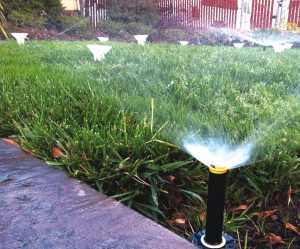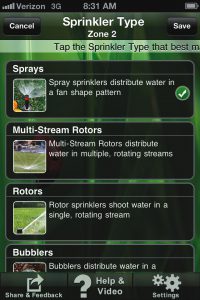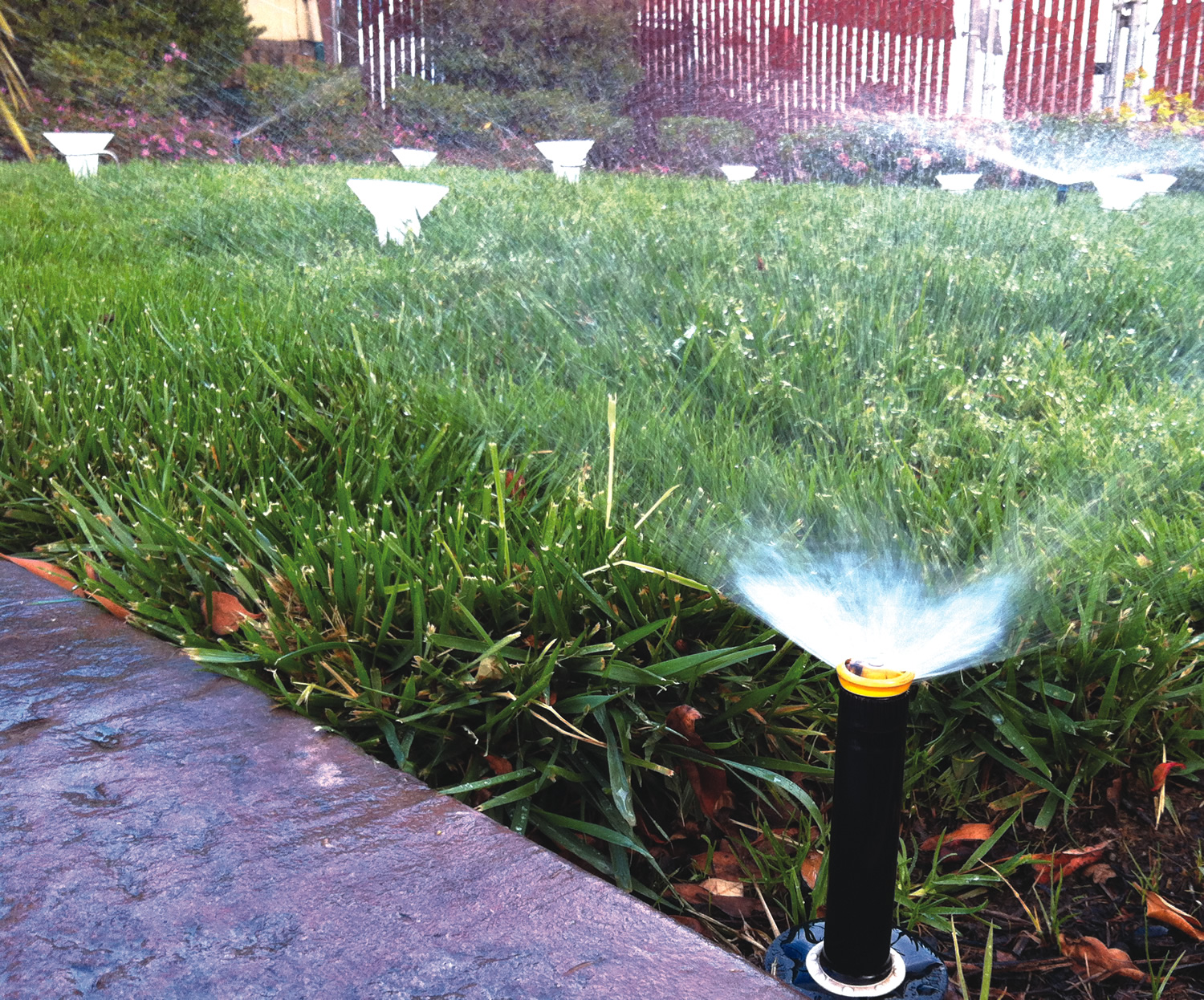Mulch and compost producer develops software application to improve efficiency of landscape irrigation systems.
Nora Goldstein
BioCycle April 2012, Vol. 53, No. 4, p. 41

Catch cans measure the output per hour of a watering system, as well as uniformity of sprinkler coverage, to establish a base watering schedule.
Many homeowners and commercial landscapers use programmable irrigation controllers, but often don’t utilize the features to create appropriate watering schedules. “We have a Lawn Watering Guide that instructs people on how to conserve with their irrigation systems,” adds Costello. “But it requires them to do a fair amount of math to determine when the sprinklers should turn on and off. Recently, I attended a water conservation showcase at the Pacific Energy Center in San Francisco. I stopped at the booth of a company named Sprinkler Times, which was displaying a new software application to provide accurate and adjustable watering schedules. We were intrigued.”
Sprinkler Times is an online program and tablet and smart phone app that creates a customized sprinkler watering schedule to conserve water. It was developed by Tom Del Conte and Logan Oates, the Water Manager at Del Conte Landscaping in Fremont, California. In addition to the landscaping company, Del Conte owns Vision Recycling, a composting and mulch production facility. He became a certified irrigation auditor in 1988 to better utilize water conservation methods in their landscaping projects and services. “To put out water using a scientific method seemed to be obviously necessary,” says Del Conte. “Over the years, there has been a lot of dialogue about water conservation but very little practical application. Part of the reason is that doing the measurements and math to calculate a watering schedule is very time consuming. Also water has, until now, been so cheap that there wasn’t an incentive to use less. Essentially what Logan and I did is develop the scientific engine behind the water audit, so that the end user can set up the watering schedule in minutes. Sprinkler Times was established to market the application.”

The Sprinkler Times program customizes the base schedule, using details such as the type of sprinkler.
Residential Water Use
Costello saw a fit for Sprinkler Times within the city’s existing outreach and education program for residential water conservation. This includes its Water-Wise Home Survey, a free service to help single- and multifamily residential customers use their water more efficiently and reduce their bills. A Water Conservation Representative visits the homes and evaluates water usage, including toilet flush volumes and faucet and showerhead rates, and provides free high-efficiency replacement fixtures if warranted. The representative will also inspect a home’s irrigation system and help with irrigation scheduling.
“We’re looking at the Sprinkler Times tool replacing our printed Lawn Watering Guide,” Costello explains. “The city is planning to purchase a bulk package of registrations, which we will provide to homeowners free for one year’s usage. There will be a link on our website, and homeowners will get a free promo code. In addition, our Water Conservation Representative will have an instructional card with the promo code that they will give to homeowners during visits. They will also offer to assist the customer with Sprinkler Times data input and programming the resulting irrigation schedule into their controller.”
A significant benefit of the program is that it tailors the water schedule to the lawn’s ability to actually absorb the water being applied. “Many homeowners just have pop-up sprinklers run for 20 minutes straight,” he says. “Only the water applied in the first few minutes actually gets to the plants or lawn; the rest is just pooling and running off. The more appropriate watering schedule is to have multiple start times, e.g., 6:00 am, 8:00 am and 10 am, with sprinklers running for 5 minutes each time.” The software has an adjustment feature if the irrigation is under- or over-applying water. Sprinkler Times also emails a notice each month to homeowners to remind them to adjust the watering rates. “In April and May, watering rates are moderate, and then they kick up in June and especially July,” Costello adds. “But it is in August, September and October where most of the water is wasted. The amount of solar radiation dictates the plant’s watering needs, so as the days get shorter, the application rate should get tweaked downward. Sprinkler Times prompts homeowners to make the appropriate seasonal adjustments.”
Del Conte notes that a traditional home or commercial landscape water audit develops a base watering schedule. It typically starts by setting out “catch cans” (cylinders with measured throat openings to catch the water) to measure the output per hour of the watering system, as well as the uniformity of coverage from the sprinkler heads. The output of the sprinkler per hour is then calculated, and a base watering schedule established. “To get to that point is so much work that in 99 percent of the cases, people think they are done after just doing the base program,” says Del Conte. “But a proper water audit specifies establishing a base schedule and then fine-tuning that schedule over the next few weeks. That typically yields another 25 to 40 percent in water savings. A key feature of Sprinkler Times is making the tweaking step simple.”
20% By 2020
Another component of Napa’s water conservation program is Water-Wise Landscaping, which encourages use of native and low-water use plants. A “Cash for Grass” incentive provides up to a $500 rebate for single-family residential sites and up to $2,500 for multi-family and commercial sites that replace thirsty lawns with climate-appropriate plants, permeable hardscapes or artificial grass. Workshops are another component of Water-Wise Landscaping, including one dealing with site preparation. “This workshop covers preparing soil, amending it with compost and then of course mulching to retain moisture and prevent weed growth,” says Costello. “The city’s recycling staff also teams up with Master Gardeners and others to put on free home composting trainings. And with lawn conversions, when we really get the compost amendment into the soil — the new plants just go nuts.”
In 2009, California passed a Water Conservation Act that sets a goal of reducing urban water consumption (per capita demand) by 20 percent by 2020. It incorporates a 10-year baseline of water usage starting from the mid-1990s. “Napa is considered an urban center,” he explains. “In mid-2011, we had to submit our plan to achieve the 20 percent reduction. Our baseline is 165 gallons per capita per day (gpcd), so 20 percent less is 132 gpcd by 2020. Landscape usage of water is a primary target, especially as that represents over half of drinking water consumption in the city. We also are switching large irrigation users such as golf courses, cemeteries, and corporate parks to recycled water from the wastewater treatment plant.”










